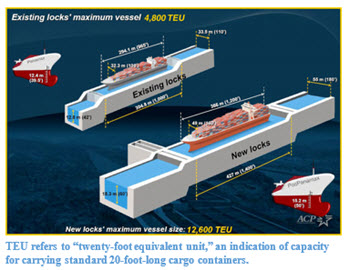WASHINGTON, June 29, 2016 - Mike Steenhoek says the opening of the expanded Panama Canal last weekend has the potential to have a “substantial and long-lasting impact on the global economy, including U.S. agriculture.”
Steenhoek, the executive director of the Soy Transportation Coalition, was on hand Sunday in Panama to watch a Chinese freighter loaded with nearly 9,500 metal cargo containers make the initial transit through new locks that allow bigger ships to navigate the historic 50-mile long waterway connecting the Pacific Ocean and the Caribbean Sea. The $5.4 billion expansion began nearly a decade ago.
The so-called Third Set of Locks Project is intended to double the capacity of the canal by adding a new lane of traffic for bigger ocean-going vessels. The new locks permit the passage of “neo-Panamax” ships as wide as a football field (160 feet) and four times as long (1,200 feet) with drafts of 50 feet. The original canal could not accommodate ships that measured more than 106 feet by 965 feet by 39.5 feet. The larger ships can carry over twice as much cargo.
At a ceremony the evening before the passage, Steenhoek said the canal administrator, Jorge Luis Quijano announced that the new, expanded canal has received 170 bookings – most of which are container vessels and liquefied natural gas (LNG) or liquefied petroleum gas (LPG) vessels.
“Given the significant width of LNG and LPG vessels, the Panama Canal heretofore has not been able to accommodate such shipments via the original locks. The larger locks will be able to accommodate them – opening up a new business line for the canal. It is projected that the expanded canal will be able to handle 10-12 transits each day. This will add to the approximately 40 transits a day the original two-lane canal accommodates,” Steenhoek said.
Before
Sunday’s inaugural transit, the Panama Canal Authority used a 115,000
deadweight ton (dwt) dry bulk vessel to successfully test one of the new set of
locks. Dry bulk vessels are used for transporting soybeans, grain and other
commodities such as coal. Such vessels utilizing the original canal are usually
50,000 to 60,000 dwt vessels.
Steenhoek says thus far, no soybean or grain vessels have booked a transit for the new, expanded canal, but he says such bookings will likely occur later in the year following the U.S. harvest.
“Given how the new canal will be able to handle ships over twice the size of the current ‘Panamax’ vessels, the ability to load a ship with substantially more revenue-producing freight will present a compelling option for soybean and grain shippers as they strive to remain profitable in an increasingly competitive global market,” Steenhoek said.
Each year, approximately 600 million bushels of U.S. soybeans transit the Panama Canal – the No. 1 agricultural commodity using the waterway. But will there be enough demand to take advantage of the canal’s increased capacity? Steenhoek is betting yes.
“As you know, demand ebbs and flows, but the long-term trajectory for soybean demand – particularly in Asia – is favorable,” he said in an e-mail.
The expansion project, which began in 2007, includes the construction of two new sets of locks – one each on the Atlantic and Pacific sides – and excavation for new entrance channels to the new locks. The existing channels had to be widened and deepened, and the water level of Gatun Lake – the source of fresh water that allows the gravity-operated canal to function – had to be raised. The project was originally due to be completed by August 2014 to coincide with the 100th anniversary of the original canal, but, the opening was pushed back by construction delays.
The expansion is designed to make the canal a more efficient option for freight companies shipping goods from China and other Asian countries to the East Coast. But many U.S. ports are still unprepared to handle the larger ships. That, combined with the current weakness in global freight traffic, means it may take some time before the traffic justifies the investment.
Steenhoek notes that on the East Coast, the ports of New York/New Jersey, Baltimore and Miami have deepened their channels to 50 feet – allowing them to accommodate the larger ships. Traffic into New York will be limited, however, by Bayonne Bridge which doesn’t provide sufficient clearance for the larger ships. Savannah is currently deepening its channel to 47 feet, Charleston has started its project to deepen to 52 feet within the next five years, and Houston has a 45-foot depth.
The 200-mile stretch of the Mississippi River from Baton Rouge to the Gulf of Mexico is maintained at 45 feet. Steenhoek said. “There’s congressional authorization to go to 50 feet, but the question is whether federal funding will enable that,” he said.
(To view a video explaining the Panama Canal Expansion Project, click here.)
#30
For more news, go to: www.Agri-Pulse.com

